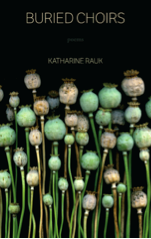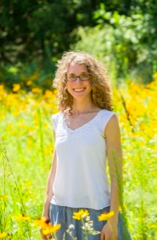
Buried Choirs by Katharine Rauk
Tinderbox Editions
$15, 62 pages
published July 2016
The work of Marianne Moore, arguably our quirkiest American modernist, has recently enjoyed an overdue revival. Perhaps in our precipitous moment of technological obsession and ecological ruin, Moore’s poems affirm curiosity, morality, and respect for the natural world as bedrock values in our literature and our democracy. In “Avec Ardeur,” Moore cheekily lectures Ezra Pound, ending with a curt final couplet: “Nothing mundane is divine;/Nothing divine is mundane.” The poems of Katharine Rauk embody this bold sentiment, and though she foregoes Moore’s stiff jargon, she nonetheless shares the master’s bewitching imagination and transformative powers. Buried Choirs, Rauk’s debut collection, documents her invention, attentiveness, and technical skill, serving as a testament to the strong work to be found among our burgeoning independent presses.
Rauk’s best poems enact magical observation to disrupt our complacency and jostle our senses, thus revealing the wonders all around us. In “Transmission,” arguably the book’s most comical poem, we meet George, who “had an orgasm every time/he saw, or even thought about,/a safety pin.” The narrative delivers plenty of chuckles from this odd conceit, but halfway through, Rauk complicates and enlarges the poem by revealing that a tumor is the cause of his erotic anomaly. Ironically, George’s lifesaving surgery not only leaves him sexually despondent, but his return to normalcy creates an emotional chasm within his marriage. The poem ends with the melancholy image of George staring at his wife longingly from his side of the bed, “the length of his thin body quivering/in darkness—desperate to divine the static/emitting from the satellite dish of her face.” “Transmission” serves as a powerful allegory about conformity, healing, and desire, and reminds us that we are most alive when we celebrate our strangeness and allow our vulnerabilities to bring us closer to those we love. “Nobody,” another remarkable poem, brims with transformations, as these lines will attest:
Because the roads
are in love with rain and leave
themselves like silk stockings
all over the city. Because you can
slice open a dogwood bud and little storms
spill out like bells chiming every hour on the hour
before dissolving into the wind.
Few things are less appealing to our sense of touch than the grit and grime of rain-slick asphalt, but here, roads take on the erotic sensuality of stockings hastily discarded in an act of lovemaking. In an equally potent metaphor, the delicate interior of an opened bud becomes as arresting and grand as church bells pealing through a city. “Nobody” brims with such inversions. A few lines later, we encounter the desire to lose oneself as a yearning to be “ground into grey gears of sea.” By incessantly blurring the boundaries between the organic world and our manmade one, Rauk universalizes one of our most private emotions—the need to jettison our identities, if only temporarily—and illustrates how even nature echoes this ache.
Buried Choirs never strays far from ecopoetical considerations, and frequently depicts nature as a realm of sumptuous mystery worthy of our awe. “The Universe” begins by noting “two nutmegs may be struck together/to make sparks,” and ten lines later, offers a credo that perfectly encapsulates Rauk’s guiding principle: “To compose/oneself in the face of whatever/emptiness sings into the loosening/currents is to be alive.” The third and final section of Buried Choirs meditates almost exclusively on the wonders of nature, including the rollicking lyric “Beautiful Pathology,” the night ode “Why I Sing,” and the book’s final ecumenical prayer “A Small Hymn.” “An Open Letter to My Imaginary Friend,” a poem from much earlier in the collection, is a vibrant example of Rauk’s spiritual vision, wherein a unified existence can be achieved through ego loss and an outward gaze. The poem follows below in its entirety:
I have written a song
in which I am just one bar
of soap upon which water
can play its innumerable
fingers. I grow
smaller and smaller until
I cease to exist
except in your head,
which is what I invented
it to do. In there
I can say that white cloud
and be understood
because of the field
of language where I mean
to lie down with you.
Though the wind blows
the clover away, I’m good
at keeping things
quiet. Here, take it,
this chain of sunlight
I’ve woven for our hair.
Throughout, Rauk’s deft command of enjambment endures as her most striking technical gift, which heightens her wit, pacing, and tone. In “On Being Asked by My Daughter If I Can Cry Underwater” and “Casida of the Weeping,” Rauk’s enjambed lines extend each pregnant pause, exaggerating her delightful paraprosdokians. In “Reckoning,” enjambment serves as the poem’s chief propulsive force, defying expectations in lines such as “Because the river is always/somersaulting into tomorrow” and “as if x really equals why/we are here.” Elsewhere, such as the heartsick “Cairn” and the nightmarish “Horn Solo on the Banks of the River Styx,” Rauk’s line breaks grant her language a fierce staccato rhythm that accentuates her melancholy:
There are no words
that can hitch
hike up the lone high
way of song to hot
wire the corpse
of everything you left
to joyride broke
cornfields beneath
a carousel sky.
The weakest poems in Buried Choirs coast on whimsy without developing a guiding conflict or charge. “Dowsing,” a brief prose poem, begins with a melodramatic occurrence of the pathetic fallacy: “When Marco asked his mother what the crab would do without legs, the silence slowly rose about his chest and lapped at the corners of the butter dish.” As it unfurls, the poem would have us believe that Marco is some sort of modern-day Bartleby, endlessly distraught at the realization that people eat animals. Despite this narrative structure, “Dowsing” doesn’t develop character or arc, preferring instead to catalog the increasingly bizarre woes of a figure that remains unconvincing. Additionally, for all of its attempts at conjuring, “Ritual” feels falsely authoritative and directionless, which are problems evident in its opening lines: “I set a corncake at the edge/of the woods and/wait because I heard/that’s where you go/to make friends.” Finally, the eight lines of “All That You Have” feel wispy and incomplete, and fail to take us beyond that familiar metaphor where life becomes song.
These concerns aside, Buried Choirs remains a refreshing debut, marked by its richness and originality. Tinderbox Editions, a new independent press that grew out of Tinderbox Poetry Journal under the direction of poet and editor Molly Sutton Kiefer, deserves credit for establishing such high standards—in both literary merit and production values—during their first year of publication. One hopes they continue to champion female voices and first-book poets, enriching American poetry for many years to come.
As a companion to Adam Tavel’s review of Buried Choirs, by Katherine Rauk, we offer an interview with our own Associate Editor for Special Projects, the estimable Nancy Mitchell, followed by detailed biographical material.

NM: Hi Katie. Congratulations on your new book, Buried Choirs. I spent a lot of time with it before I looked at Adam Tavel’s review, and I wasn’t surprised that he praises your use of enjambment as “perhaps her most striking technical gift, which heightens her wit, pacing, and tone.” Dazzling examples abound throughout your book, such as in “Horn Solo on the Banks of the River Styx,” which Adam parses in the above review, and in one of my favorites below:
The Price
Something I can’t bear is that I think
I will never learn what love is
eating out of your hand: cracked
corn, maybe millet, black oil
sunflower seed. The glossy shell
is what I think of when
I am not thinking of you
thinking of yesterday and the price
of tulips in Kalamazoo
or other people’s eyes or
whatever it is you think of
when you’re not thinking of me
as I really am: a calendar
full of all the Thursdays that were
and will ever be: like doorframes
stacked one up against
another’s emptiness: and then some
kind of wind blowing through.
I’m impressed with how, literally at each turn, you move us into another emotionally specific territory. In the first two couplets, the noun love in “learn what love is” shifts from the objective case to the subjective “eating out of your hand; cracked/corn, maybe millet, black oil.” Very cool. What sense of immediacy, spontaneity in these poems!—it’s as if I’m reading over your shoulder as you write. I think of Frost’s “No surprise for the writer, no surprise for the reader.” How much of these enjambments, turns surprise you?
KR: Sometimes I do get surprised by my own enjambments—which is the whole point! A rupture in the line can complicate or challenge the meaning of that line, or what I thought I was thinking. More than once I have been pulled up short: well, where I am supposed to go now?
NM: I guess I’m going to have to ask that boring interview question, because I’m really curious: what is your writing process?
KR: I always fumble this question! The difficulty is that my own writing process is still enigmatic to me. And that, of course, is why I find writing so irresistible. I have the idea that all art is an attempt to breach the boundaries of what we think we know.
NM: Yes, ye old reach exceeding the grasp.
KR: Maybe that’s why I like to play around with enjambment, that weird swerve from one line to the next. And it really is play; I can test the joints of a sentence to see what will happen if I put pressure here or there, and I do take pleasure in the process.
NM: When you “test the joints of a sentence,” do you mean you write your poems in prose and then go back and put them in verse form? Can you give an example from the above poem, or from one of my other favorites in your book, “MY GOD?”
KR: No, I don’t begin writing the lines out in prose. But I will consciously investigate my original line breaks to see if I can make something more interesting. For example, “The Price” used to open
Something I can’t bear is
I think I will never learn what love is…
At some point, I figured I’d fool around with other possible iterations of these lines. I got excited when I moved “I think” up onto the first line to make “Something I can’t bear is that I think…” In this particular poem, the speaker interrogates who is thinking what and when—and it gets a bit dizzying—so I was pleased that the first line now expressed a kind of exhaustion with thinking itself. I stumbled across this particular line by making a minor adjustment at a possible hinge in the sentence.
NM: It was a great revision choice!
KR: Thank you! Sometimes, though, the whole process is alchemical. A cool enjambment will just happen, and I can’t explain a thing about it.
NM: That’s the magic we write for, isn’t it—that surprise? Have you always been aware of your special talent with enjambments?
KR: I never used to pay line breaks much attention. I subscribed to the idea that the line should reflect a unit of breath, and I would just stick in a break whenever it seemed like a natural spot to pause. I was more interested in images anyway. They seemed to contain all the magic of the poem for me, like little trapdoors to a somewhere else.
NM: Yes, the image was always the starting point for me, before a line, before a word.
KR: I still adore the image as much as ever, but I’ve discovered that even a pedestrian sentence—if you break it open in the right way—can accrue a lot of weight as it unlocks down the page.
NM: Almost a gravitational pull, like that wooden Jacob’s ladder toy. And if everything else is working really well, the enjambment can support the image, frame it, in a way, as your poems do! Sometimes, in my own writing, I fret that breaking the lines so consciously might sacrifice the power of the image, but your poems use both to great advantage.
KR: I love your comparison to the Jacob’s ladder toy! Exactly. And inherent in that comparison is a velocity, a movement. The etymology of “verse” is “to turn”: you get to the end of the line and now have to change directions. A friend once told me that in ancient Greek drama, the words to be sung by the chorus were in verse—as opposed to matters of plot, which were written in prose—and that as they sang, the chorus would dance across the stage, turning back in the other direction to enact the turn at the end of the line. This means that line breaks were manifested in literal movements of the body! I’m not sure if this is true, but I like to imagine that it is.
NM: Yes, and we see more of that turning back in the other, or even another direction in the subsequent couplets in “The Choice”:
whatever it is you think of
when you’re not thinking of me
as I really am: a calendar
full of all the Thursdays that were
and will ever be: like doorframes
stacked one up against
another’s emptiness: and then some
kind of wind blowing through.
By the way, as an anti-resolutionist, I love how the last image doubly refuses resolution by literal dissolution “wind blowing through” the “emptiness.” There’s a wonderful surrealist quality in your poems which we see In “Congratulations, We Are Pleased,” (which is a particularly successful collaboration of image and enjambment.) The following lines…
—that unrepeatable
playlist of the sea. It knows how to crash
a party, shine its headlights
through the cement-block windows of your brain
where all the depressed poems are
passed out drunk on the floor.
…put me in mind of artist Remedios Varo, and poet Bill Knott. “Transmission,” which Adam praises in his review, puts me in mind of Tom Lux. Did/do particular artists, writers shade your work?
KR: I considered using a Remedios Varo painting for the cover of my chapbook Basil a few years ago!
NM: No way! Which one?
KR: The title of the painting is “Personaje,” though she has a few by that name. In this particular painting, a figure holds a book in one hand as she rides some sort of bicycle-ish contraption supported by a dozen spindly wheels and pinwheels. Black and gold paint feather out from her head into the darkness. I’m drawn to Varo’s paintings of wheels, hair, gold threads, cloaked figures with owls inside the cupboards of their chests…
NM: Sounds fascinating; I’ll try and find it.
KR: Another artist I return to often is Federico García Lorca, especially his essay “Play and Theory of the Duende,” in which he suggests that creativity arrives on “wings of rusty knives,” that it is something mysterious, dark, and broken.
NM: Yes, “wings of rusty knives” takes the top of my head off.
KR: Jack Spicer wrote a series of letters to Lorca, and in one he says, “Loneliness is necessary for pure poetry.” Lorca was, at this point in time, already dead. I think that line has stuck with me because (as we were discussing earlier) it suggests how art embodies a kind of incurable longing to connect—not just with a reader, but with some even bigger mystery beyond.
NM: I agree. Do you read other poets while you’re working on a book?
KR: Some poets that I reread often while working on the poems in this book are Linda Gregg, Diane Seuss, Mary Ruefle, Kevin Young, Dorothea Laskey, Charles Simic, and Joanna Klink.
NM: What a line up, and no surprise that they are among my favorites as well. And, by the by, I see the amazing Dianne Seuss praised Buried Choirs with a lovely blurb. She’s right on when she writes that your “ poems represent the lyric in action: a gusty engagement in self-composition, world building, cosmos-reaming that that is as audacious as it is gorgeous.”
Katie, thank you; this chat has been a real pleasure. I’m looking forward to your next collection of “lyrics in action.” As a special treat to our readers we’ll close with one of your new poems “Upon Examination” which you’ve been so gracious to share with Plume. Readers, more audacity, more gorgeousness:
UPON EXAMINATION
My friend has a tumor in his belly.
Cut it out! he said
after I sent him the second card
as if the mail was the cancer
and it was all my fault
everyone was sending him poems
about birds. There once was a man
who visited the Natural History Museum
regularly over a three year period,
posing as a wheelchair bound invalid
just to smuggle out 10,000 rare eggs.
Such desire for beauty
is a sickness. I would hollow out
a secret compartment in my bedframe
to stash the specimens
I stole from a red-backed shrike.
To hold one in my hands—
all its gold-spackled
fragility born of emptiness
—is to know I’d do goddamn
just about anything to keep
my beautiful counterfeit life.
Katharine Rauk is the author of Buried Choirs (Tinderbox Editions) and the chapbook Basil (Black Lawrence Press). She has poems published in Pleiades, Harvard Review, DIAGRAM, Hayden’s Ferry Review, Best of the Net 2012, and elsewhere. She reviews books for SCOUT and teaches at North Hennepin Community College.
Nancy Mitchell is a 2012 Pushcart Prize winner and the author of The Near Surround (Four Way Books, 2002) and Grief Hut (Cervena Barva Press, 2009). Her recent poems appear, or will soon appear, in Poetry Daily, Agni, Washington Square Review, Green Mountains Review, Tar River Poetry, Columbia College Literary Review, and Thrush, among others. Mitchell teaches at Salisbury University and serves as the Associate Editor of Special Features for Plume. You can reach Nancy Mitchell at nmitchellebert@comcast.net.


